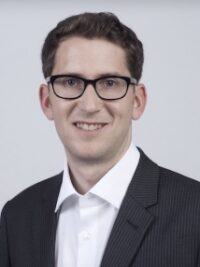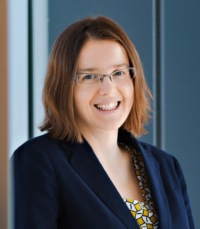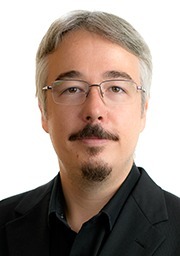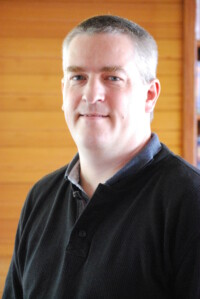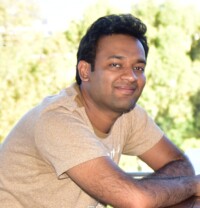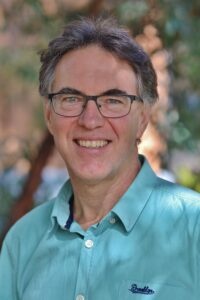-

Stefan Leutenegger
Imperial College London
Stefan Leutenegger is a Senior Lecturer (USA equivalent Associate Professor) in Robotics at Imperial College London. He leads the Smart Robotics Lab at Imperial and co-leads the Dyson Robotics Lab with Prof. Andrew Davison. His research is centred around autonomous robot navigation: robots need dedicated sensing capabilities as well as algorithms for localisation inside a potentially unknown environment. This includes localisation and mapping with a suite of sensors, most importantly cameras, to be processed efficiently to yield accurate results at real-time.
-

Tobi Delbruck
ETH Zurich and The Institute of Neuroinformatics, Zurich
Tobi Delbruck received a Ph.D. degree from Caltech in 1993 in the inaugural class of the Computation and Neural Systems program founded by John Hopfield, as a student of Christof Koch, David van Essen and Carver Mead. Currently he is a Professor of Physics and Electrical Engineering at ETH Zurich in the Institute of Neuroinformatics, University of Zurich and ETH Zurich, Switzerland, where he has been since 1998. He co-organized the Telluride Neuromorphic Cognition Engineering workshop and the live demonstration sessions at ISCAS and NIPS. Delbruck is past Chair of the IEEE CAS Sensory Systems Technical Committee. He worked on electronic imaging at Arithmos, Synaptics, National Semiconductor, and Foveon and has founded 3 spin-off companies, including www.inilabs.com , which supports basic R&D on neuromorphic sensory processing. He has been awarded 9 IEEE awards and was named a Fellow of the IEEE Circuits and Systems Society for his work on neuromorphic sensors and processing. Besides playing with neuromorphic sensors, he likes to read, play tennis and basketball, and practice card magic on unwary subjects.
-

Dana Kulić
Monash University
Dana Kulić received the combined B. A. Sc. and M. Eng. degree in electro-mechanical engineering, and the Ph. D. degree in mechanical engineering from the University of British Columbia, Canada, in 1998 and 2005, respectively. From 2006 to 2009, Dr. Kulić was a JSPS Post-doctoral Fellow and a Project Assistant Professor at the Nakamura-Yamane Laboratory at the University of Tokyo, Japan. In 2009, Dr. Kulić established the Adaptive System Laboratory at the University of Waterloo, Canada, conducting research in human robot interaction, human motion analysis for rehabilitation and humanoid robotics. Since 2019, Dr. Kulić. is a professor at Monash University, Australia. Her research interests include robot learning, humanoid robots, human-robot interaction and mechatronics.
-

Donald Dansereau
University of Sydney
Dr Donald Dansereau is a senior lecturer in the school of Aerospace, Mechanical and Mechatronic Engineering, and the Perception Theme Lead for the Sydney Institute for Robotics and Intelligent Systems. His work explores how new imaging devices can help robots see and do, encompassing the design, fabrication, and deployment of new imaging technologies. In 2004 he completed an MSc at the University Calgary, receiving the Governor General’s Gold Medal for his pioneering work in light field processing. In 2014 he completed a PhD on underwater robotic vision at the Australian Centre for Field Robotics, followed by postdoctoral appointments at QUT and Stanford University. Donald’s industry experience includes physics engines for video games, computer vision for microchip packaging, and chip design for automated electronics testing.
-

Peter Corke
Queensland University of Technology
Peter Corke is a robotics researcher and educator. He is the distinguished professor of robotic vision at Queensland University of Technology, director of the ARC Centre of Excellence for Robotic Vision and Chief Scientist of Dorabot. His research is concerned with enabling robots to see, and the application of robots to mining, agriculture and environmental monitoring. He created widely used open-source software for teaching and research, wrote the best selling textbook “Robotics, Vision, and Control”, created several MOOCs and the Robot Academy, and has won national and international recognition for teaching including 2017 Australian University Teacher of the Year. He is a fellow of the IEEE, the Australian Academy of Technology and Engineering, the Australian Academy of Science; former editor-in-chief of the IEEE Robotics & Automation magazine; founding editor of the Journal of Field Robotics; founding multi-media editor and executive editorial board member of the International Journal of Robotics Research; member of the editorial advisory board of the Springer Tracts on Advanced Robotics series; recipient of the Qantas/Rolls-Royce and Australian Engineering Excellence awards; and has held visiting positions at Oxford, University of Illinois, Carnegie-Mellon University and University of Pennsylvania. He received his undergraduate and masters degrees in electrical engineering and PhD from the University of Melbourne.
-

Tom Drummond
Monash University
Professor Drummond is a Chief Investigator based at Monash. He studied a BA in mathematics at the University of Cambridge. In 1989 he emigrated to Australia and worked for CSIRO in Melbourne for four years before moving to Perth for his PhD in Computer Science at Curtin University. In 1998 he returned to Cambridge as a post-doctoral Research Associate and in 1991 was appointed as a University Lecturer. In 2010 he returned to Melbourne and took up a Professorship at Monash University. His research is principally in the field of real-time computer vision (ie processing of information from a video camera in a computer in real-time typically at frame rate), machine learning and robust methods. These have applications in augmented reality, robotics, assistive technologies for visually impaired users as well as medical imaging.
-

Ravi Garg
University of Adelaide
Ravi Garg is an Associated Research Fellow with the Australian Centre for Robotic Vision and is part of the Australian Centre for Visual Technologies at The University of Adelaide as senior research associate since April 2014. He is working with Prof. Ian Reid on his Laureate Fellowship project named “Lifelong Computer Vision Systems”. Prior to joining University of Adelaide, he finished his PhD from Queen Mary University of London under the supervision of Professor Lourdes Agapito where he worked on Dense Motion Capture of Deformable Surfaces from Monocular Video. His current research interest lies in building learnable systems with little or no supervision which can reason about scene geometry as well as semantics. He is exploring how far the visual geometry concepts can help current deep neural network frameworks in scene understanding. In particular, his research focuses on unsupervised learning for single view 3D reconstruction, visual tracking in monocular video and weakly or semi-supervised semantic reasoning in images or videos.
-

Robert Mahony
Australian National University
Robert Mahony is a Professor in the Research School of Engineering at the Australian National University. He received his BSc in 1989 (applied mathematics and geology) and his PhD in 1995 (systems engineering) both from the Australian National University. He is a fellow of the IEEE and was president of the Australian Robotics Association from 2008-2011. His research interests are in non-linear systems theory with applications in robotics and computer vision. He is known for his work in aerial robotics, geometric observer design, matrix subspace optimisation and image based visual servo control.
-

Dylan Campbell
Australian National University
Dylan joined the Centre as a Research Fellow at the Australian National University (ANU) in August 2018. Previously, he was a PhD student at ANU and Data61/CSIRO, where he worked on geometric vision problems, and a research assistant at Data61/CSIRO. Dylan received a BE in Mechatronic Engineering from the University of New South Wales. He has broad research interests within computer vision and robotics, including geometric vision and human-centred vision. In particular, he has investigated geometric sensor data alignment problems, such as camera localisation, simultaneous localisation and mapping, and structure from motion. He is currently looking at the problems of recognising, modelling, and predicting human actions, poses and human-object interactions with a view to facilitate robot-human interaction as part of a Centre project. You can view his personal website here.
